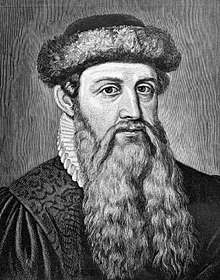Johann Gutenberg Biography
German inventor and printer, Johann Gutenberg (1397–1468) was born at Mainz, Germany. He is long credited with the invention of a method of printing from movable type, including the use of metal molds and alloys, a special press, and oil-based inks. With some refinements and increased mechanization, his method remained the principal means of printing until the late 20th cent. His type, which was hand set with characters of equal height, was printed on handmade paper.
Life
Evidence indicates that Gutenberg was trained as a goldsmith, and entered a partnership in which he taught his friends his secret profession of printing in the 1430s. He lived in Strasbourg for some years, and he may have made his great invention there in 1436 or 1437; he returned to Mainz in 1446 and formed a partnership with a goldsmith, Johann Fust.
Gutenberg’s goal was to mechanically reproduce medieval liturgical manuscripts without losing their color or beauty of design. The masterpiece of his press has been known under several names: the Gutenberg Bible; the Mazarin Bible; and in modern times, as the 42-line Bible, for the number of lines in each printed column.
Fust’s demand for repayment of sums advanced resulted in a settlement in which Gutenberg abandoned his claims to his invention and surrendered his stock, including type and the incomplete work on the 42-line Bible, to Fust, who continued the business and completed printing the Bible. Although the work bears no place of printing, date, or printer’s name, it is usually dated to 1455. Printed in an edition of about 180 copies, it is the earliest extant Western book printed in movable type.
It is thought that Gutenberg re-established himself in the printing business with the aid of Conrad Humery in 1460. In 1465, The Elector of Mainz, Archbishop Adolf of Nassau, presented him with a benefice yielding an income and various privileges. There is a Gutenberg Museum in Mainz.